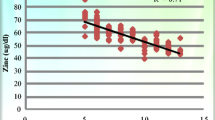Abstract
The health effects of long-term ingestion of rare earth elements (REEs) on the villagers living in high-REE-background areas in South Jangxi Province, China were studied. Major health complaints from the REE area population included indigestion, diarrhea, abdominal distension, anorexia, weakness, and fatigue, especially after high-fat or high-protein intake. Liver function tests were conducted for adult villagers. Among them, 45 live in a heavy rare earth (HREE) area, 62 in a light rare earth (LREE) area, and 49 in the control area. Test results showed that serum total protein and globulin from both HREE and LREE areas, as well as albumin from the LREE area, were significantly lower (p<0.05–0.01) compared to the results from the control area, whereas albumin from the HREE area showed no significant variance (p>0.05). The chi-square test showed that Serum-glutamic pyruvic transaminase (SGPT) in both areas were not significant (p>0.05), whereas the IgM in the HREE area was significantly elevated. It is our conclusion that long-term ingestion of REE affected activities of some digestive enzymes, causing malabsorption and indigestion, and might further lead to a low-protein effect for the villagers in the LREE area. However, the damage to the liver was rather mild. The elevation of IgM was probably the result of stimulation induced by the formation of a large amount of granules as a result of direct binding of REEs to globulin or albumin (combination of REEs with globulin or albumin).
Similar content being viewed by others
References
W. F. Zhu, S. Q. Xu, H. Zhang, et al., Investigation of children intelligence quotient in the areas with high REE background (I)—REE bioeffects in the REE-high areas of southern Jiangxi Province, Chin. Sci. Bull. 41(23), 1977–1981 (1996).
W. F. Zhu, S. Q. Xu, P. P. Shao, et al., Bioelectrical activity of the central nervous system among populations in a rare earth element area, Biol. Trace Element Res. 57, 71–77 (1997).
W. F. Zhu, S. Q. Xu, D. S. Wu, et al., Investigation on arteriosclerosis among population in a rare earth area in south China, Biol. Trace Element Res. 59, 93–98 (1997).
W. F. Zhu, S. Q. Xu, P. P. Shao, et al., Investigation on intake allowance of rare earth—a study on bio-effect of rare earth in South Jiangxi, China, China Environ. Sci. 17(1), 63–66 (1997) (in Chinese).
Y. J. Ji, Rare earths toxicologically evaluation of safety in agriculture in Rare Earths in Agriculture, B. S. Guo, W. M. Zhu, B. K. Xiong, Y. J. Ji, J. Liu, and Z. M. Wu, eds., China Agricultural Science and Technology, Beijing, pp. 262 (1990).
P. Arvela, O. Graiewski, B. Von Lehmann, and E. Oberdisse, Effect of lanthanons on substrate-induced difference spectrain in rat liver microsomes, Experintia 32, 491–493 (1976).
P. Arvela, B. Von Lehmann, O. Grajewski, and E. Oberdisse, Effect of praseodymium on drug metabolism in rat liver smooth rough endoplasmic reticulum, Experientia 36, 860–861 (1980).
G. C. KyKer, E. A. Crees, V. M. Sivaramakrishnan, C. H. Steffee and M. Stewart, Fatty infiltration due to rare earths, Fed. Proc. 16, 207 (1957).
F. Y. Yuan, Liver diseases and digest system diseases, in The Course of Diagnose and Treatment of Liver Diseases and Physical Systemic Diseases, Y. He and F. Y. Yuan eds., People's Military Medical Publisher, Beijing, pp. 102–106 (2002).
R. H. Tang, W. Huang, F. Luo, G. Q. Xiao, and Y. F. Liu, Study of distribution and accumulation of rare earth ytterbium and cerium in mice, China Environ. Sci. 13, 20–23 (1992).
S. L. Zhong and W. Z. Ming, Distribution of rare earth elements in bodies of human and animals, in Bionorganic Chemistry of Rare Earth Elements, J. Z. Ni, ed., Science, Beijing, pp. 102–104 (1995) (in Chinese).
O. Johnsson, G. Perault, L. Savoie, and B. Tuchwerber, Action of various metallic chlorides on calcaemia and phosphataemia, Br. J. Pharmacol. Chemother. 33, 91–97 (1968).
C. H. Evans, The interaction of Lanthanides with amino acids and proteins, in Biochemistry of the Lanthanides, C. H. Evans, ed., Plenum, New York (1990).
H. Rinderknecht and R. M. Friedman, The effect of Lanthanide ions on enteropeptidase—catalyzed activation of trypsinogen, Biochim. Biophys. Acta 452, 497–502 (1976).
F. Shadid, J. E. Gomez, E. R. Birnbaum and D. W. Darnall, Lanthanide-induced N-F transition and acid expansion of Seriurn albumin, J. Biol. Chem. 257, 5618–5622 (1982).
B. Rosoff and H. Spencer, Studies on electrophoretic binding of radioactive rare earths, Health Phys. 28, 611–612 (1975).
Z. Z. Zou, X. H. Wang, and X. X. Zhu, A morphological study on the effects of a rare earth element ytterbium on mouse liver and kidney, J. Norman Bethune Univ. Med. Sci. 19, 224–225 (1993).
Z. Z. Zou, Z. B. Li, X. H. Wang, and X. X. Zhu, Study on the distribution and deposition of cerium, europium, gadolinium and terbium in mouse liver with electron microscopy and X-ray microanalysis, Chin. J. Histchem. Cytochem. 1, 208–214 (1992).
R. Montgomery, R. L. Dryer, T. W. Conway, and A. A. Spector, eds., Biochemistry—A Case-Oriented Approach, Mosby, London, Chap. 13 (1983); translated into Chinese by X. L. Xu, People's Health, Beijing, pp. 662 (1988).
C. G. Dos Romendios, ionic radius selectivity of skeletal muscle membranes, Nature 170, 750–751 (1977).
N. Itoh and M. Kawakita, Characterization of Gd3+ and Tb3+ binding sites on Ca2+−Mg2+-adnosine triphosphatase of sacoplasmic relicudum, J. Biochem. 95, 661–669 (1984).
Author information
Authors and Affiliations
Rights and permissions
About this article
Cite this article
Zhu, W., Xu, S., Shao, P. et al. Investigation on liver function among population in high background of rare earth area in South China. Biol Trace Elem Res 104, 1–7 (2005). https://doi.org/10.1385/BTER:104:1:001
Received:
Revised:
Accepted:
Issue Date:
DOI: https://doi.org/10.1385/BTER:104:1:001




